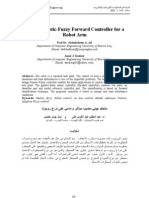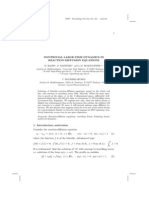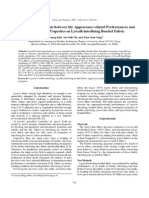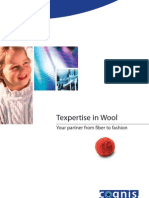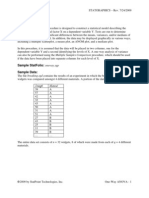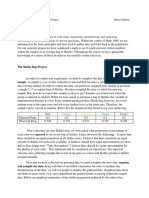Comparison of Multiple Linear Regressions (MLR) and Artificial Neural Network (ANN) in Predicting The Yield Using Its Components in The Hulless Barley
Comparison of Multiple Linear Regressions (MLR) and Artificial Neural Network (ANN) in Predicting The Yield Using Its Components in The Hulless Barley
Uploaded by
hhedfiCopyright:
Available Formats
Comparison of Multiple Linear Regressions (MLR) and Artificial Neural Network (ANN) in Predicting The Yield Using Its Components in The Hulless Barley
Comparison of Multiple Linear Regressions (MLR) and Artificial Neural Network (ANN) in Predicting The Yield Using Its Components in The Hulless Barley
Uploaded by
hhedfiOriginal Title
Copyright
Available Formats
Share this document
Did you find this document useful?
Is this content inappropriate?
Copyright:
Available Formats
Comparison of Multiple Linear Regressions (MLR) and Artificial Neural Network (ANN) in Predicting The Yield Using Its Components in The Hulless Barley
Comparison of Multiple Linear Regressions (MLR) and Artificial Neural Network (ANN) in Predicting The Yield Using Its Components in The Hulless Barley
Uploaded by
hhedfiCopyright:
Available Formats
American-Eurasian J. Agric. & Environ. Sci.
, 10 (1): 60-64, 2011 ISSN 1818-6769 IDOSI Publications, 2011
Comparison of Multiple Linear Regressions (MLR) and Artificial Neural Network (ANN) in Predicting the Yield Using its Components in the Hulless Barley
1
Mohammad Zaefizadeh, 2Majid Khayatnezhad and 2Roza gholamin
1
Islamic Azad University, Ardabil Branch, Ardabil, Iran Young Researchers Club, Islamic Azad University, Ardabil Branch, Ardabil, Iran
Abstract: In this study 40 genotypes in a randomized complete block design with three replications for two years were planted in the region of Ardabil. The yield related data and its components over the years of the analysis of variance were combined.Results showed that there was a significant difference between genotypes and genotype interaction in the environment. MLR and ANN methods were used to predict yield in barley. The fitted model in a yield predicting linear regression method was as follows: Reg = 1.75 + 0.883 X1 + 0.05017X2 +1.984X3 Also, yield prediction based on multi-layer neural network (ANN) using the Matlab Perceptron type software with one hidden layer including 15 neurons and using algorithm after error propagation learning method and hyperbolic tangent function was implemented, in both methods absolute values of relative error as a deviation index in order to estimate and using duad t test of mean deviation index of the two estimates was examined. Results showed that in the ANN technique the mean deviation index of estimation significantly was one-third (1 / 3) of its rate in the MLR, because there was a significant interaction between genotype and environment and its impact on estimation by MLR method.Therefore, when the genotype environment interaction is significant, in the yield prediction in instead of the regression is recommended of a neural network approach due to high yield and more velocity in the estimation to be used. Key words: ANN % MLR % Hulless Barley INTRODUCTION There are important limitations, including the necessity of observing regression assumptions, significant non-linear relationships and multiple callinearity between independent variables and the presence of genotype and environment interaction, also replication interactions within the environment (E1) in the combined analysis of variance in national uniform tests, led to be predicting the MLR model non efficient [1]. However, the prediction in an artificial neural network method (ANN) always takes place according to any data situation (without limitation) based on initial training [2]. Each artificial neural network of an input layer, one or more hidden layers and an output layer has been established as the following general model is defined [3]:
Fig. 1: Artificial neural net work models However, networks can be different depending on type and number of layers and having control feed back and, etc. [2]. Hitherto almost seven different methods for artificial neural networks have been developed and each one can be used in a different analysis rather than classical statistical methods [4].When the non-linear relationship between dependent and independent
Corresponding Author: Majid Khayatnezhad, Young Researchers Club, Islamic Azad University, Ardabil Branch, Ardabil, Iran. E-mail: Khayatneghad@yahoo.com.
60
Am-Euras. J. Agric. & Environ. Sci., 10 (1): 60-64, 2011
variables exists, the ANN method will be more efficient [2]. There is no need in ANN method to observe some of the regression assumptions. Other studies have compared two methods to show that in predicting the dependent variable, the ANN method results are more accurately than MLR [2, 5- 9]. Although the ANN is considered as a powerful technique for non-linear models [10]. But some researchers in this linear model have also applied and reported it better than the regression model [4, 9, 11, 12]. According to the present constraints on regression techniques to predict yield (i) based on its components and its importance in the reform election of superior genotypes as for high impact of environment on the multiple gene characteristics, this research on a real data from farm experiments of hulas barely to compare two methods of regression and artificial neural network approach was used. MATERIALS AND METHODS Farm Experiments and Numerical Resources (Database): An experiment in a randomized complete block design with forty genotypes of hulless barely was planted (advanced lines) in three replications of two agricultural years (1983-1985) in the research farm of Islamic Azad University of Ardabil. Each experimental plot included five 2.5 m culture lines with distance of 20 cm were formed, eliminating the margin effect, 5 samples were selected so that for each trait in total of plots and years totally 1200sample was selected. In addition to yield per unit plot, important yield components such as cluster length, total grain in the main cluster, grain weight and plant height were measured. Statistical Methods: Each year, Simple variance analysis for traits derived from a simple farm experiment and also the combined analysis of variance test was performed for two years where the F test based on the mathematical expectancy mean squares (EMS) was conducted. MLR analysis for yield using independent variables to the stepwise variable election method was conducted and based on variables remaining in the equation model of the line was estimated then in 20 percent of samples (test ), all of i ?s based on this model again was estimated and the average absolute value relative error: | i-i | was calculated. Artificial neural network (ANN) in Matlab software using three input variables, the numbers of fertile tillers and grains per main spike and grain weight was taught. The used Model was of a multi-layer Perceptron. Total data for predicting the yield of hulless barely were
1200 samples that the training data and testing and verification of total data randomly were selected and respectively made up of 60% and 20% and 20% of the total data. In the network, the changes of error recovery in terms of the epoch and error absolute value (AE) of learning data and authentication was also calculated and figured out. After training the network, also the Yi values using Xs available in test samples in the network recalculated and the absolute value of deviation in this method | i-i | was obtained. Mean absolute value of deviation of i which was calculated in two ways by i using ANN and MLR methods to the way of paired t-test were compared. RESULTS AND DISCUSSION Multiple Linear Regression Models: Analysis of Combined variance results showed that there was significant differences between the interaction of genotype and genotypes in the year (G * E) in terms of yield, number of fertile tillers, spike and one thousand grain weight. Final model Regression analysis in the Stepwise method for grain yield after the multiple callinearity tests, Watson and Gold Camera Field Cont was fitted to the following: reg = 1.75 + 0.883X1 + 0.05017X2+ 1.984X3 Where fertile tillers = X1, the main spike and one thousand grain weight = X2 = X3 were. According to the regression variance analysis table (Table 1), this model in a probability level of 0/0001 was significant. Explanation coefficient in the above model was equal with R2=0.678. Thus that nearly 68% of the yield changes by three variables of fertile tillers, main spike and one thousand grain weight can be justified. Artificial Neural Networks: Based on comparing methods and changing the layers and number of neurons in each network, the best neural network was selected with the following characteristics due to the minimum of root mean square (RMS).Neural network structure used as (1-15-3) that has three neurons in the input layer (number of fertile tillers, number of grains in the main (cluster) spike and one thousand grains weight), 15 neurons in the hidden layer and one neuron in output layer (yield), (Figure 1). Of a stimulating function of the hyperbolic tangent in hidden layer and linear activator function in output layer was used.
61
Am-Euras. J. Agric. & Environ. Sci., 10 (1): 60-64, 2011
Table 1: Regression variance analysis for the yield through the remaining variables in linear regression models S.O.V Regression Remaining df 3 236 (MS) 365.25 2.49 F 126.2 Prob 0.0001
Table 2: results of the comparison of deviation absolute value average of actual Y which was brought on by Y in the two methods of MLR and ANN Standard Groups | i-i | in regression | i-i | in ANN Mean 1.334 0.358 deviation 1.074 0.597 Mean difference -0.975 t 18.37 Prob 0.0001
Fig. 2: The designed Network diagram. In the network, the error recovery changes based on epoch is mapped and shown in Figure 2. The error absolute value (AE) and authentication and learning data are given in Figure 3. The error of these data in the replication 500 was converged means that epoch = 500 is the best learning mode of network that if most of this learning continues, over train in the network will occur.
Comparison Between the Two Methods for Estimating Yield: Using estimated i in both of regression and artificial neural network methods, the rate of the deviation absolute value from the regression line from the actual yield (i) were calculated and compared and its comparison results using paired t test was listed in Table 2. The results of this comparison showed that with a lower probability level in 0.0001 of the mean absolute deviations from the regression line (as an indicator of the diversion in the estimation) in the regression method significantly was more than the artificial neural network method. This means that the amount of error in the estimation by the regression method was more than the error in artificial neural network method, thus can be stated that the neural network for estimating in the barely genotypes yield was more effective than regression approach. However, that the correlation between the two estimates for every x existing in the artificial neural network models and multiple linear regression was significant and positive. The multiple linear regression models are the most important method of predicting the yield by its components. The estimated multiple linear regression models for yield based on the three remaining variables indicate that the selection of genotypes with high yield through its components can be used. Mohammadi [13] also reported the number of fertile tillers and the number of grains in the spike as the important trait in showing the yield in the barley genotypes, although these two traits and traits of grain filling time, days to appearing of the spike and plant (bush) height totally were showing the yield rate of 49% in the regression model. In the present model, the yield explanation rate by three traits was 68% that represents the best selection of independent
Fig. 2: Error recovery changes based on epoch in the network 62
Am-Euras. J. Agric. & Environ. Sci., 10 (1): 60-64, 2011
Fig. 3: Error absolute value (AE) learning data and authentication variables for yield. The findings were consistent with the results of Alizadeh Gharib [14]. Existence and necessity of observing the multiple defaults (or assumptions) for design of regression models ex parte and the impact of other conditions, including the existence of a significant interaction between genotype and environment (G * E) in the regression models from other hand causes in the predictions of Each unit with available Xs in the model deviation rate vary. However, the cause of this deviation in addition to genotype environment interaction effect could be related to violating regression assumptions are including multiple callinearity and dependency of errors, etc. which is generally observed less by users.Estimates and forecasts based on artificial neural network as an efficient method of learning based on samples towards regression method in the linear and non linear relationships have been recommended [6, 15- 18] because the smart artificial neural networks considering all the circumstances can do the estimates with lesser skew based on the single samples. The comparison of skewed values |Yi-| showed in both experiments that the skewed values in the ANN method are significantly less than the MLR method. That can be related to the lack of neural network limitations than other statistical methods, especially parametric method. So that more yield and accuracy of neural network forecasting method is achieved than the correlation and multiple regressions [7, 13, 16, 18]. General health indicators than the sequential method of least squares logistics regressions have been reported but in comparing both multiple regression and neural network for formulation optimization of lypoprolid acetate in liposomes, two methods yield reported the same [8]. So regarding the lack of restrictions on artificial neural network application (ANN) and the extent of its application in biological sciences and also a fast and easy prediction it can be rather than regression techniques as an alternative method in plant breeding and Forecast quantitative traits in barley polygenic in hulless barely used. Because most of the relationships between variables in the hulless barely are not necessarily linear constraints and it is using constraints of linear regression with this method is disappeared. REFERENCES 1. Molazem, D., M. Valizadeh and M. Zaefizadeh, 2002. North West of genetic diversity of wheat. J. Agricultural Sci., 20: 353-431. Adielsson, S., 2005. Statistical and neural networks analysis of pesticide losses to surface water in small agricultural catchments in Sweden. M.Sc. Thesis, Sweden University, Sweden. Gevery, M., I. Dimopoulos and S. Lek, 2003. Review and comparison of methods to study the contribution of variable in artificial neural network models. Eco. Modeling, 160: 249-264. Miao, Y., D. Mulla and P. Robert, 2006. Identifying important factors influencing corn yield and grain quality variability using artificial neural networks. Springer, 7: 117-135. Pastor, O., 2005. Unbased sensitivity analysis and pruning techniques in ANN for surface ozone modeling. Ecological modeling, 182: 149-158.
2.
3.
4.
5.
63
Am-Euras. J. Agric. & Environ. Sci., 10 (1): 60-64, 2011
Gail, B., C. Viswanthan, T.R. Nelakantan, L. Srinivasa, R.Girones, D. Lees, A. Allard and A. Vantarakis, 2005. Artificial neural networks prediction of viruses in shellfish. Appl. and Environ. Microbiol., 31: 5244-5253. 7. Diane, M.L. and P.A. David, 2007. For predicting facial cal form concentrations. Hydrological sci. J., 52: 713-731. 8. Salt, D.W., N. Yildiz and D.J. Livingstone, 1999. The use of artificial neural networks in QSAR. Pesticide Sci., 36: 161-170. 9. Starett, S.K., Y. Najjar, S.G. Adams and J. Hill, 1998. Modeling pesticide leaching from golf courses using artificial neural networks. Communications in Soil Science and Plant Analysis, 29: 3093-3106. 10. Lek, S., M. Delacoste, P. Baran, I. Dimopoulos, J. Lauga and A. Aulagnier, 1996. Application of neural networks to modeling nonlinear relationships in Ecology. Ecological Modeling, 90: 39-52. 11. Manel, S., S.M. Dias and S.J. Ormerod, 1999. Comparing discriminant analysis, neural networks and logistic regression for predicting species distributions: a case study with a Himalayan river Bird. Ecological Modeling, 120: 337-347. 12. Ozesmi, S.L. and U. Ozesmi, 1999. An artificial neural network approach to spatial habitat modeling with interspecific interaction. Ecological Modeling, 116: 15-31.
6.
13. mohammadi, M., 2002. Physiological traits associated with the performance of two barley genotypes in normal conditions and drought stress. Seed and Plant Research Magazine, 17: 61-72. 14. Alizadeh Gharib, F., 2006. Effect of dose and timeconsuming and yield components in the DMS naked barley. M.Sc. Thesis, Azad University, Ardabil, Iran. 15. Chen, Y.K., D.Z. Chen, C.Y. He and S.X. Hu, 1999. Quantative structure-activity relationships study of herbicides using neural networks and different statistical methods. Chemo metrics and Intelligent Laboratory System, 45: 267-276. 16. Arulsundar, N., N. Subramanian and R.S.R. Murth, 2005.Comparison of artificial neural networks and multiple liner regression in optimization of formulation parameters of leuprlide acetate loaded leptosomes. J. Pharm. Sci., 8: 243-258. 17. Dahnal, V., K. Kuca and D. Jun, 2005. What are artificial neural networks and what they can do?. Fac. Biomed. Papmed. Palacty olomuac Univ., Czech. Republic, 149: 221-224. 18. Nikolopoulos, K., P. Goodwin, A. Patelis and V. Assimatopoulos, 2007. Forecasting with cue information: A comparison of multiple regressions with alternative forecasting approaches. European J. Operational Res.,180: 354-368.
64
You might also like
- Spare PartsDocument8 pagesSpare PartsSaurabh R Singh100% (1)
- Assignment # 1Document28 pagesAssignment # 1Hashim javedNo ratings yet
- Ann QsarDocument9 pagesAnn QsarVictor Erdy SugionoNo ratings yet
- IJAIADocument8 pagesIJAIAAdam HansenNo ratings yet
- DTSpaper110915 PDFDocument9 pagesDTSpaper110915 PDFManohar LalNo ratings yet
- ANN-Bp of ExtrusionDocument10 pagesANN-Bp of Extrusionসীমান্ত শুভNo ratings yet
- WWW Frank Dieterle deDocument2 pagesWWW Frank Dieterle deSaravanan VelNo ratings yet
- Comparison of Machine Learning RegressionDocument25 pagesComparison of Machine Learning RegressionmudassarNo ratings yet
- Andrew FDocument4 pagesAndrew Famnaashiq5577No ratings yet
- 2023 Johnston - Comparison of Machine Learning Methods Emulating Process Driven Crop Models PDFDocument37 pages2023 Johnston - Comparison of Machine Learning Methods Emulating Process Driven Crop Models PDFPegicNo ratings yet
- Application of Artificial Neural Network For Path Loss Prediction in Urban Macrocellular EnvironmentDocument6 pagesApplication of Artificial Neural Network For Path Loss Prediction in Urban Macrocellular EnvironmentAJER JOURNALNo ratings yet
- Dchip, MAS e RMADocument8 pagesDchip, MAS e RMAYuri Nagamine UrataNo ratings yet
- Term Paper in Stat 276: An Exposition of A Published ArticleDocument8 pagesTerm Paper in Stat 276: An Exposition of A Published ArticleAngie Tobias - LozanoNo ratings yet
- Neural Network, Sewage TreatmentDocument10 pagesNeural Network, Sewage TreatmentKumar GauravNo ratings yet
- Assessment of Internal Quality of Blueberries Using Hyperspectral Images With Selected WavelengthsDocument6 pagesAssessment of Internal Quality of Blueberries Using Hyperspectral Images With Selected Wavelengths'Kesowo Hari MurtiNo ratings yet
- Comparison of Imputation Techniques After Classifying The Dataset Using KNN Classifier For The Imputation of Missing DataDocument4 pagesComparison of Imputation Techniques After Classifying The Dataset Using KNN Classifier For The Imputation of Missing DataInternational Journal of computational Engineering research (IJCER)No ratings yet
- Nonlinear Identification of PH Process by Using Nnarx Model: M.Rajalakshmi, G.Saravanakumar, C.KarthikDocument5 pagesNonlinear Identification of PH Process by Using Nnarx Model: M.Rajalakshmi, G.Saravanakumar, C.KarthikGuru SaravanaNo ratings yet
- 2008 - Augmented Three-Mode MIA-QSAR Modeling For A Series ofAnti-HIV-1Document6 pages2008 - Augmented Three-Mode MIA-QSAR Modeling For A Series ofAnti-HIV-1Natânia RodriguesNo ratings yet
- Statistical Approaches to Gene x Environment Interactions for Complex PhenotypesFrom EverandStatistical Approaches to Gene x Environment Interactions for Complex PhenotypesNo ratings yet
- Inteligencia ArtificialDocument15 pagesInteligencia ArtificialSebastian Vallejo RangelNo ratings yet
- Why Use Elitism and Sharing in A Multi-Objective Genetic Algorithm?Document8 pagesWhy Use Elitism and Sharing in A Multi-Objective Genetic Algorithm?Osy OsyNo ratings yet
- Final DocumentDocument9 pagesFinal DocumentSurya RNo ratings yet
- Analytical Study of Biometrics Normalization and Fusion Techniques For Designing A Multimodal SystemDocument6 pagesAnalytical Study of Biometrics Normalization and Fusion Techniques For Designing A Multimodal SystemijaertNo ratings yet
- Identification of Parameter Correlations For Parameter Estimation in Dynamic Biological ModelsDocument12 pagesIdentification of Parameter Correlations For Parameter Estimation in Dynamic Biological ModelsQuốc Đông VũNo ratings yet
- tmp25AA TMPDocument19 pagestmp25AA TMPFrontiersNo ratings yet
- Selection of Efficient Wavelengths in NIR Spectrum For Determination of Dry Matter in Kiwi FruitDocument12 pagesSelection of Efficient Wavelengths in NIR Spectrum For Determination of Dry Matter in Kiwi Fruitkby36No ratings yet
- Application of Artificial Neural Networks For Response 2012 Journal of AdvaDocument11 pagesApplication of Artificial Neural Networks For Response 2012 Journal of AdvanazrulharizNo ratings yet
- Online Genetic-Fuzzy Forward Controller For A Robot Arm: Prof Dr. Abduladeem A. AliDocument14 pagesOnline Genetic-Fuzzy Forward Controller For A Robot Arm: Prof Dr. Abduladeem A. AlinguyendattdhNo ratings yet
- Clustering SOM FCM in EJOR PDFDocument18 pagesClustering SOM FCM in EJOR PDFJaime Andrés Aranda CubilloNo ratings yet
- ANN in Dimensionality Reduction of Gene Expression DataDocument3 pagesANN in Dimensionality Reduction of Gene Expression Dataananyadash1018No ratings yet
- Sediment Transport Prediction by Using 3-Layer Feedforward MLP NetworksDocument7 pagesSediment Transport Prediction by Using 3-Layer Feedforward MLP NetworksAkhmad HananNo ratings yet
- Influence of Selection On Structure Learning in Markov Network EDAs: An Empirical StudyDocument22 pagesInfluence of Selection On Structure Learning in Markov Network EDAs: An Empirical StudyMartin PelikanNo ratings yet
- Multimodal Biometrics: Issues in Design and TestingDocument5 pagesMultimodal Biometrics: Issues in Design and TestingMamta KambleNo ratings yet
- Prediction of Two Phase Flow PDFDocument5 pagesPrediction of Two Phase Flow PDFPujara ManishNo ratings yet
- Mathematical Programming For Piecewise Linear Regression AnalysisDocument43 pagesMathematical Programming For Piecewise Linear Regression AnalysishongxinNo ratings yet
- PAKDD 2006 Data Mining Competition: Project ReportDocument32 pagesPAKDD 2006 Data Mining Competition: Project ReportamcucNo ratings yet
- Pesticide Residue Mass SpectralDocument13 pagesPesticide Residue Mass Spectraljabinaya62No ratings yet
- Ijmet: ©iaemeDocument8 pagesIjmet: ©iaemeIAEME PublicationNo ratings yet
- Resolving Gene Expression Data Using Multiobjective Optimization ApproachDocument7 pagesResolving Gene Expression Data Using Multiobjective Optimization ApproachIJIRSTNo ratings yet
- Genetic Feature Selection For A P300 Brain Computer InterfaceDocument4 pagesGenetic Feature Selection For A P300 Brain Computer InterfaceHugo Leonardo RufinerNo ratings yet
- Chemometrics and Intelligent Laboratory Systems: 10.1016/j.chemolab.2016.07.011Document26 pagesChemometrics and Intelligent Laboratory Systems: 10.1016/j.chemolab.2016.07.011JessicaNo ratings yet
- 1232 PaperDocument12 pages1232 Paperneh naragNo ratings yet
- Computers and Electronics in Agriculture: P.S. Maya Gopal, R. Bhargavi TDocument9 pagesComputers and Electronics in Agriculture: P.S. Maya Gopal, R. Bhargavi TG DharaniNo ratings yet
- AssignmentDocument14 pagesAssignmentkioskNo ratings yet
- Soft Computing Based Analysis For Crop Yielding Prediction Using Spiking Neural Network With GATE-Neural Network For Industry Revolution 5.0Document31 pagesSoft Computing Based Analysis For Crop Yielding Prediction Using Spiking Neural Network With GATE-Neural Network For Industry Revolution 5.0numbrNo ratings yet
- Splicing ExplanationDocument20 pagesSplicing ExplanationkyudionNo ratings yet
- Reference 1Document6 pagesReference 1Shreya GaikwadNo ratings yet
- Material RemovalDocument10 pagesMaterial RemovalIAEME PublicationNo ratings yet
- Asthi Kshaya ThesisDocument8 pagesAsthi Kshaya Thesislupitavickreypasadena100% (2)
- BMC Bioinformatics: A Meta-Data Based Method For DNA Microarray ImputationDocument10 pagesBMC Bioinformatics: A Meta-Data Based Method For DNA Microarray ImputationSaba TajNo ratings yet
- Mango Leaf CNNDocument26 pagesMango Leaf CNNAman ANANDNo ratings yet
- Novel Approach For Estimating Monthly Sunshine Duration Using Artificial Neural Networks: A Case StudyDocument10 pagesNovel Approach For Estimating Monthly Sunshine Duration Using Artificial Neural Networks: A Case StudyLAIDI MaamarNo ratings yet
- I and I Are The Pheromone and Heuristic Values For TheDocument3 pagesI and I Are The Pheromone and Heuristic Values For ThemibNo ratings yet
- Multimodal Biometric System Using Face, Ear and Gait BiometricsDocument4 pagesMultimodal Biometric System Using Face, Ear and Gait Biometricsبورنان محمدNo ratings yet
- Growth OF BY OF System: Plant THE HybridDocument4 pagesGrowth OF BY OF System: Plant THE HybridRadha R DuttaNo ratings yet
- Mixture of Partial Least Squares Regression ModelsDocument13 pagesMixture of Partial Least Squares Regression ModelsalexeletricaNo ratings yet
- Data Mining Discretization Methods and PerformancesDocument3 pagesData Mining Discretization Methods and PerformancesAashish KhajuriaNo ratings yet
- Synthesis of Thinned Linear Antenna Arrays With Fixed Sidelobe Level Using Real-Coded Genetic Algorithm G. K. MahantiDocument10 pagesSynthesis of Thinned Linear Antenna Arrays With Fixed Sidelobe Level Using Real-Coded Genetic Algorithm G. K. MahantiNaren PathakNo ratings yet
- ML (AutoRecovered)Document4 pagesML (AutoRecovered)IQRA IMRANNo ratings yet
- SVM Quantile DNADocument9 pagesSVM Quantile DNAXiao YaoNo ratings yet
- Averrmectin B1b Production Optimization From Streptomyces AvermitilisDocument8 pagesAverrmectin B1b Production Optimization From Streptomyces AvermitilisRubina NeloferNo ratings yet
- Herb Leaves Recognition Using Gray Level Co-Occurrence Matrix and Five Distance-Based Similarity MeasuresDocument13 pagesHerb Leaves Recognition Using Gray Level Co-Occurrence Matrix and Five Distance-Based Similarity MeasuresRizal IsnantoNo ratings yet
- 47 Équations Fonctionnelles: 47.1 L'équation Fonctionnelle de Cauchy: F (X + Y) F (X) +Document12 pages47 Équations Fonctionnelles: 47.1 L'équation Fonctionnelle de Cauchy: F (X + Y) F (X) +hhedfiNo ratings yet
- The Sensory Panel Applied To Textile Goods A New Marketing ToolDocument14 pagesThe Sensory Panel Applied To Textile Goods A New Marketing ToolhhedfiNo ratings yet
- 1714914Document13 pages1714914hhedfiNo ratings yet
- An Intelligent Inverse Method For Characterization of Textile Reinforced Thermoplastic Composites Using A Hyperelastic Constitutive ModelDocument12 pagesAn Intelligent Inverse Method For Characterization of Textile Reinforced Thermoplastic Composites Using A Hyperelastic Constitutive ModelhhedfiNo ratings yet
- Abstract Guideline Autex2014-ODocument1 pageAbstract Guideline Autex2014-OhhedfiNo ratings yet
- Equadiff Vienne 2007Document6 pagesEquadiff Vienne 2007hhedfiNo ratings yet
- The Correlation Analysis Between The Appearance-Related Performances and The Mechanical Properties On Lyocell-Interlining Bonded FabricDocument4 pagesThe Correlation Analysis Between The Appearance-Related Performances and The Mechanical Properties On Lyocell-Interlining Bonded FabrichhedfiNo ratings yet
- 1 s2.0 S0997753812001143 MainDocument8 pages1 s2.0 S0997753812001143 MainhhedfiNo ratings yet
- A Term of Length 4,523,659,424,929: AthiasDocument8 pagesA Term of Length 4,523,659,424,929: AthiashhedfiNo ratings yet
- Cse169 01Document49 pagesCse169 01hhedfiNo ratings yet
- A Term of Length 4,523,659,424,929: AthiasDocument8 pagesA Term of Length 4,523,659,424,929: AthiashhedfiNo ratings yet
- 1 34Document34 pages1 34hhedfiNo ratings yet
- 0 B0b004 M ZDocument8 pages0 B0b004 M ZhhedfiNo ratings yet
- CH 3Document14 pagesCH 3Wudneh AmareNo ratings yet
- STA215 STA220 Practice TestDocument13 pagesSTA215 STA220 Practice TestRevownSadaNo ratings yet
- Assignment 3 Week 3Document3 pagesAssignment 3 Week 3Chirag BharambeNo ratings yet
- Engineering Statistics & Linear Algebra: 18EC44 Model Question Paper-2 With Effect From 2019-20 (CBCS Scheme)Document4 pagesEngineering Statistics & Linear Algebra: 18EC44 Model Question Paper-2 With Effect From 2019-20 (CBCS Scheme)Nayana JahagiradarNo ratings yet
- Module 3 - DISCRETE PROBABILITY DISTRIBUTIONSDocument22 pagesModule 3 - DISCRETE PROBABILITY DISTRIBUTIONSTherese SibayanNo ratings yet
- CPE 2 2 Time Scaled Event Network Exercises MacalinaoDocument6 pagesCPE 2 2 Time Scaled Event Network Exercises MacalinaoJoshua Macalinao100% (1)
- 05 Sampling DistributionsDocument42 pages05 Sampling Distributionsarmada12No ratings yet
- Chapter 9 - Simple RegressionDocument62 pagesChapter 9 - Simple RegressionGilang Pratama100% (1)
- 4.2 Expected Value and Variance of Continuous Random VariablesDocument2 pages4.2 Expected Value and Variance of Continuous Random VariablesJoséBorjNo ratings yet
- AssignmentDocument6 pagesAssignmentParth satavara (PDS)No ratings yet
- CombinepdfDocument34 pagesCombinepdfiadeemsNo ratings yet
- One Way AnovaDocument23 pagesOne Way Anovachit cat100% (1)
- AIML Module-04Document46 pagesAIML Module-04AISHWARYA HOYSALNo ratings yet
- Syndicated Learning Program - II (SLP-II) Regression AnalysisDocument26 pagesSyndicated Learning Program - II (SLP-II) Regression AnalysisSiddhartha SharmaNo ratings yet
- Lecture Notes - Logistic RegressionDocument11 pagesLecture Notes - Logistic RegressionPrathap BalachandraNo ratings yet
- The Science of Collecting, Organizing, Summarizing, and Analyzing Information To Draw Conclusions or Answer QuestionsDocument7 pagesThe Science of Collecting, Organizing, Summarizing, and Analyzing Information To Draw Conclusions or Answer Questionsapi-438148756No ratings yet
- Problem Set 10Document2 pagesProblem Set 10KritikaPandeyNo ratings yet
- Multiple Indicator Kriging (MIK Uing StudioRMDocument41 pagesMultiple Indicator Kriging (MIK Uing StudioRMEfraim HermanNo ratings yet
- Statistics and Probability: Quarter 3 - Module 7: Calculating Mean and Variance of A Discrete Random VariableDocument27 pagesStatistics and Probability: Quarter 3 - Module 7: Calculating Mean and Variance of A Discrete Random VariableMoreal Qaz100% (1)
- Sim DiffProcDocument74 pagesSim DiffProcSarah SouidNo ratings yet
- Telecom Customer Churn Prediction Assessment PDFDocument23 pagesTelecom Customer Churn Prediction Assessment PDFPrakash Jha100% (1)
- Chi Square Test SL&HLDocument8 pagesChi Square Test SL&HLAlishaNo ratings yet
- Practice Questions - Quantitative - Reading 7Document13 pagesPractice Questions - Quantitative - Reading 7Khải HoànNo ratings yet
- Chapter 4 Introduction To ProbabilityDocument63 pagesChapter 4 Introduction To ProbabilityRituja Rane100% (1)
- Formulae and Distributions TablesDocument19 pagesFormulae and Distributions TablesViorel AdirvaNo ratings yet
- Pattern Classification: Second EditionDocument11 pagesPattern Classification: Second EditionjojoNo ratings yet
- Complete Business Statistics: Time Series, Forecasting, and Index NumbersDocument37 pagesComplete Business Statistics: Time Series, Forecasting, and Index Numbersmallick5051rajatNo ratings yet
- FAVARDocument13 pagesFAVARhakim223mohamedabdNo ratings yet



























